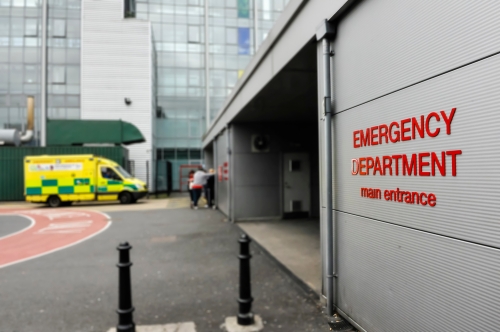Urgent and emergency care nurses worked in services this winter that were performing “far worse” than before the Covid-19 pandemic, according to a new analysis.
The Health Foundation think tank this week published a report, which identified that the health service in England was “in distress” for several months this winter.
“The crisis in A&E has been repeated across hospitals”
Patricia Marquis
The analysis looked at the extent to which urgent and emergency care disruptions were caused by higher than usual levels of winter illnesses and/or systemic weaknesses within the NHS.
Authors concluded that the NHS was performing “far worse than before the pandemic” and was reporting record or near-record levels of operational problems across urgent and emergency care.
The report set out that only 73% of all A&E patients were treated within four hours this winter, similar to the previous two winters but far below the 95% NHS target.
Performance was worse at major emergency departments, with less than 60% of patients treated within 4 hours.
Patients who needed admission were the most affected by delays, the report said.
Since the pandemic, the NHS has reported increases in ‘trolley waits’ where patients wait more than 12 hours for a hospital bed after a decision to admit, usually due to lack of available beds.
At the peaks of the past three winters, over 9% of emergency admissions involved trolley waits off over 12 hours – compared to less than 1% pre-pandemic, the report said.
These delays reached a record high of impacting 11% of emergency admissions in January 2025 – around 60,000 patients.
The analysis found that there had been a “move towards the normalisation of corridor care” in the most recent winter.
It comes as a report published in January this year by the Royal College of Nursing revealed that frontline nurses had been forced to give care in corridors, cupboards and car parks on a daily basis.
Meanwhile, last winter saw nurses and other NHS staff battling a “quad-demic” of season illnesses, comprising record influenza levels and an increase in Covid-19, respiratory syncytial virus (RSV) and norovirus.
During the winter months, some ministers attributed the huge pressure on staff to the rising levels of these illnesses.
However, the analysis by the Health Foundation has suggested that it would be wrong to solely blame pressures on the increase of seasonal illnesses.
Authors noted that pressures from flu were “certainly difficult this winter” but hospital admissions followed similar patterns to previous winters.
Similarly, it said levels of patients in hospital with flu and diarrhoea and vomiting had been high but were not “unprecedented”.
The report concluded that attributing operational problems to external factors, such as winter illnesses and higher demand, risked offering “false comfort” about the resilience of the health service.
The view of the authors was that the NHS experienced a disproportionate number of operational problems in winter 2024-25.
The report said: “This means policymakers need to focus on the underlying issues contributing to the escalating winter crises experienced since 2010 if the NHS is ever to recover the four-hour standard for A&E and respond to future national health emergencies, or even more localised major incidents.
“These underlying issues include increasing hospital capacity, improving staff morale and improving capacity in social care and community services to help reduce discharge delays – which cost the NHS far more bed days this winter than it lost to seasonal viruses.”
Royal College of Nursing director for England Patricia Marquis told Nursing Times that the report “should be a reminder to government to invest in nursing staff” especially in the community and social care.
“That is how you prevent people from ending up at A&E in the first place and reduce the pressures on an already overwhelmed workforce,” she said.

Patricia Marquis
Ms Marquis argued that nursing staff “know only too well” what is happening in the NHS in England.
She said: “The crisis in A&E has been repeated across hospitals and the treatment of patients in unsafe and undignified conditions in corridors, on trollies, and in side-rooms has become normalised.
“Similar pressures are being felt in the community where a depleted workforce faces a growing number of patients with some of the most vulnerable left without the care they need.”
As such, Ms Marquis called on the government to publish its urgent and emergency care plan – due soon – “and recognise that investment in nursing is key to reversing the crisis that continues to unfold”.
Also responding to the report, Dr Adrian Boyle, president of the Royal College of Emergency Medicine, said winter may be inevitable “but an annual NHS crisis does not have to be”.
He added: “The pinch points and areas for improvement are clear and well documented, and they are fixable with the right impetus and political focus.”
A Department for Health and Social Care spokesperson said: “Despite our actions to protect patients during the colder months, including vaccinating more people than last winter, we know hospitals are feeling the strain.
“Annual winter pressures should not automatically lead to an annual winter crisis.”
The spokesperson said the government had taken “decisive action” including ending the junior doctors’ strikes and rolling out the country’s first RSV vaccine.
It added that ministers had made the “difficult but necessary” decision to put £26bn into the NHS and social care “so we can make sure our emergency departments are fit for the future.

